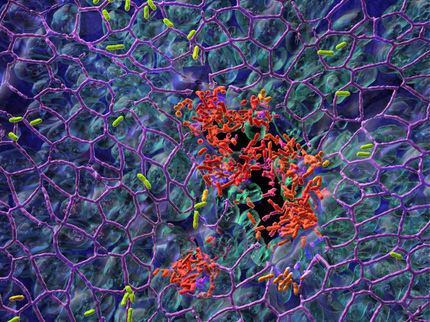An innovative antibiotic class for drug-resistant bacteria
New active compounds inspired by a bacterium
Advertisement
Antibacterial drugs are important to treat infections. But increasing bacterial resistance to current drugs — making them ineffective or only partially effective — means that new ones are urgently needed. Building on previous work, researchers from the Helmholtz Institute for Pharmaceutical Research Saarland (HIPS), together with an international team of collaborators, have demonstrated a potential antibacterial treatment from a biosynthetic derivative of darobactin, a bacterial natural product. The team reports proof-of-concept animal trials on infections caused by bacteria, including Escherichia coli and Acinetobacter baumannii that are known to develop drug-resistance. This ACS Infectious Diseases study was published during the World Health Organization’s World Antimicrobial Resistance (AMR) Awareness Week from 18 to 24 November 2024.
In 2024, the World Health Organization updated its list of bacterial pathogens that can develop resistance to antibiotics to include E. coli, A. baumannii, and Pseudomonas aeruginosa, among others. Despite the need for new antibiotics that target these priority pathogens, scientists do not have many candidates in (pre-)clinical development. One potential resistance-breaking compound is called darobactin, a naturally produced antibiotic first discovered in a bacterium by researchers in the US in 2019. Darobactin binds to an essential protein in bacterial cells and eventually causes their death. Previously, Rolf Müller, Jennifer Herrmann and colleagues identified that genetically engineered versions of darobactins have superior antibacterial activity. Specifically, a non-natural darobactin derivative (D22) inhibited growth of all critical pathogens mentioned above in lab assays.
For this new study, a larger team led by Müller and Herrmann tested the engineered compound against several priority bacterial infections in animals. First, in zebrafish embryos, D22 treatment cleared A. baumannii infection as effectively as ciprofloxacin, a broad-spectrum antibiotic used for complicated infections. Then they conducted a series of efficacy and dosing trials with mice:
- Best delivery method: Observations indicated that administering D22 as an injection was more effective than oral administration.
- Efficacy against P. aeruginosa: Repeated doses of D22 substantially limited P. aeruginosa bacterial growth in mice (thigh tissue infection) but didn’t fully clear the infection.
- Multi-dose experiments against E. coli: Administering D22 four times in 25 hours fully cleared E. coli in a severe infection model of peritonitis. Very good activity was also observed for single doses. Twice-daily D22 injections over three days significantly reduced bacterial presence in a complicated E. coli urinary tract infection, although not as effectively as the antibiotic gentamicin, which reduced bacterial loads below detection.
These results show how D22 can inhibit critical infections and highlights the compound’s promise for further development towards future clinical trials as “an innovative solution to fight antimicrobial resistance,” say the researchers.
Original publication
Andreas M. Kany, Franziska Fries, Carsten E. Seyfert, Christoph Porten, Selina Deckarm, María Chacón Ortiz, Nelly Dubarry, Swapna Vaddi, Miriam Große, Steffen Bernecker, Birthe Sandargo, Alison V. Müller, Eric Bacqué, Marc Stadler, Jennifer Herrmann, Rolf Müller; "In Vivo Activity Profiling of Biosynthetic Darobactin D22 against Critical Gram-Negative Pathogens"; ACS Infectious Diseases, 2024-11-20






















































